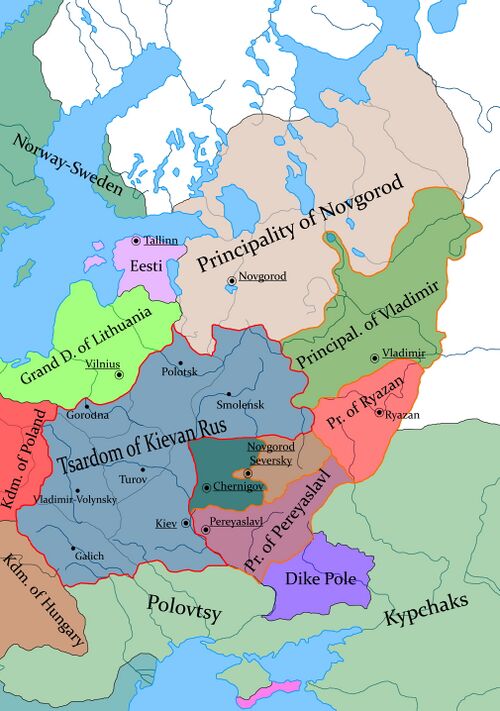Kiewan Rus
Tsardom of Kievan Rus Царство Київської Русі | |
|---|---|
| Capital and largest city | Kiev |
| Official languages | Old East Slavic |
| Recognised national languages | Old East Slavic Church Slavonic |
| Religion | Orthodox Christianity |
| Demonym(s) | Kievites |
| Government | Feudal absolute monarchy |
• Tsar | Daniel Romanovich from the Rurik dynasty |
| Legislature | Veche |
| History | |
• Established | 879 |
• Conquest of Khazar Khaganate | 965–969 |
| 988 | |
| early 11th century | |
| Area | |
• Total | 582,168 km2 (224,776 sq mi) |
• Water (%) | 6.1% |
| Population | |
• 1205 estimate | ~6,000,000 |
| Currency | Grivna (₴) |
Kievan Rus or Tsardom of Kievan Rus (Old East Slavic: Роусь, romanized: Rusĭ, or роусьскаѧ землѧ, romanized: rusĭskaę zemlę, "Rus' land") was a loose federation of East Slavic and Uralic peoples in Europe from the late 9th to the mid-13th century, under the reign of the Rurik dynasty, founded by the Varangian prince Rurik. At its greatest extent, in the mid-11th century, it stretched from the White Sea in the north to the Black Sea in the south and from the headwaters of the Vistula in the west to the Taman Peninsula in the east, uniting the majority of East Slavic tribes.
According to Rus Primary Chronicle, the first ruler to start uniting East Slavic lands into what has become known as Kievan Rus' was Prince Oleg (879–912). He extended his control from Novgorod south along the Dnieper river valley to protect trade from Khazar incursions from the east, and moved his capital to the more strategic Kiev. Sviatoslav I (died 972) achieved the first major expansion of Kievan Rus territorial control, fighting a war of conquest against the Khazars. Vladimir the Great (980–1015) introduced Christianity with his own baptism and, by decree, extended it to all inhabitants of Kiev and beyond. Kievan Rus reached its greatest extent under Yaroslav the Wise (1019–1054); his sons assembled and issued its first written legal code, the Russkaya Pravda ("Rus' Justice"), shortly after his death.
The state began to decline during the late 11th century, disintegrating into various rival regional powers. It was further weakened by economic factors, such as the collapse of Rus' commercial ties to the Byzantine Empire due to the decline of Constantinople and the accompanying diminution of trade routes through its territory. However, in 1202 Roman Mstislavich, the Grand Duke of Galicia and Volhynia, became the Grand Duke of Kiev and from 1203 to 1205 he conducted campaigns of conquest against the Principality of Polotsk and Smolensk. After that, he was crowned Tsar of the Second Kievan Rus, laying the foundation for the reunification of the lost lands.


